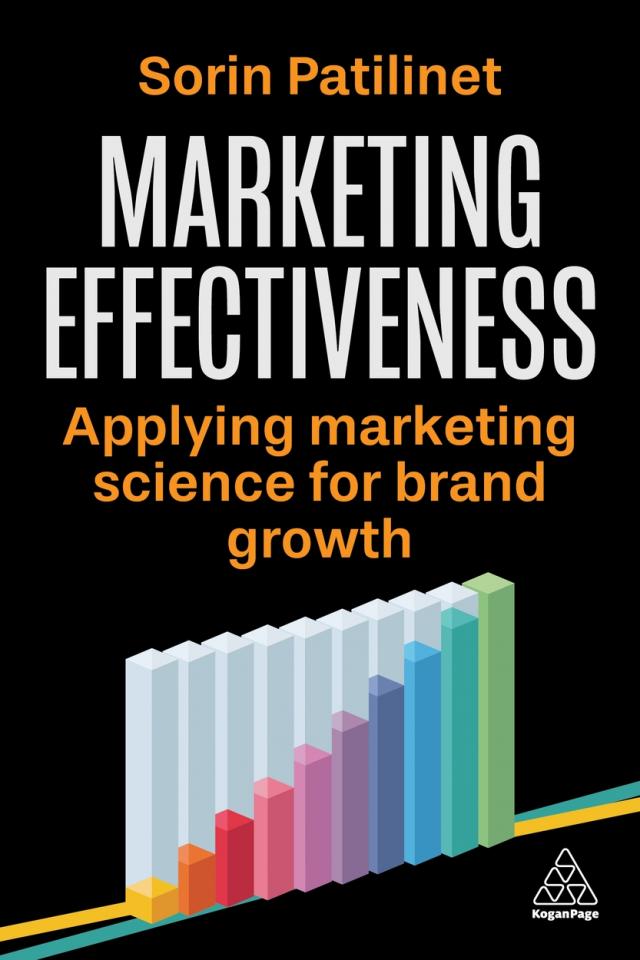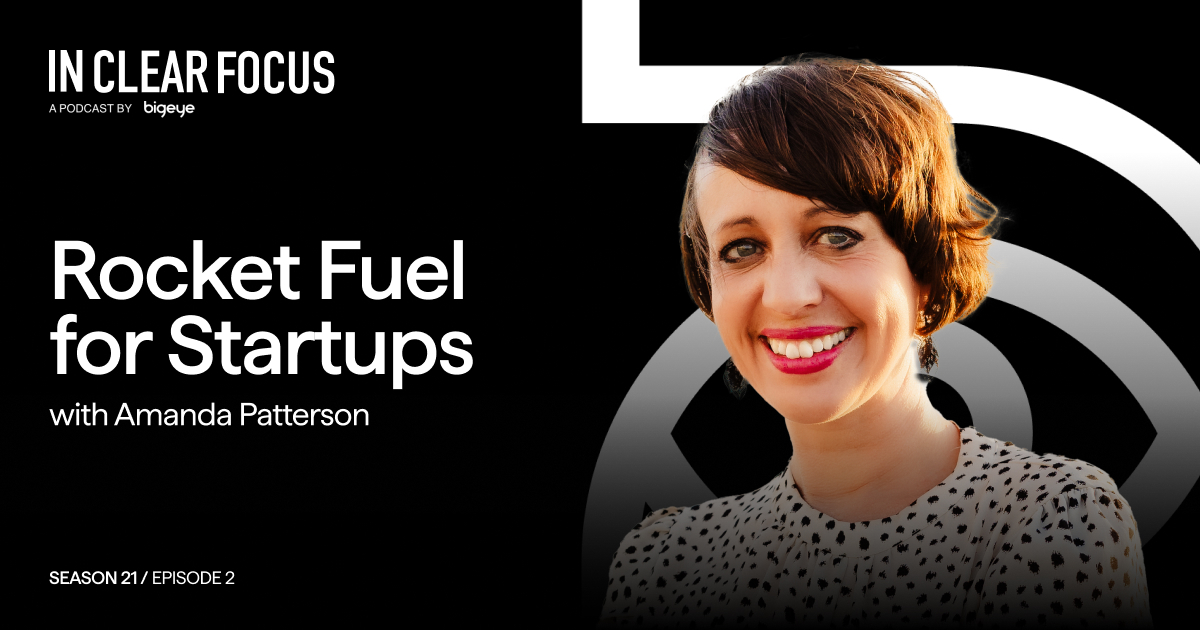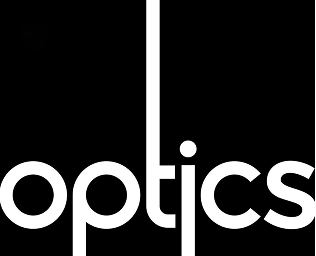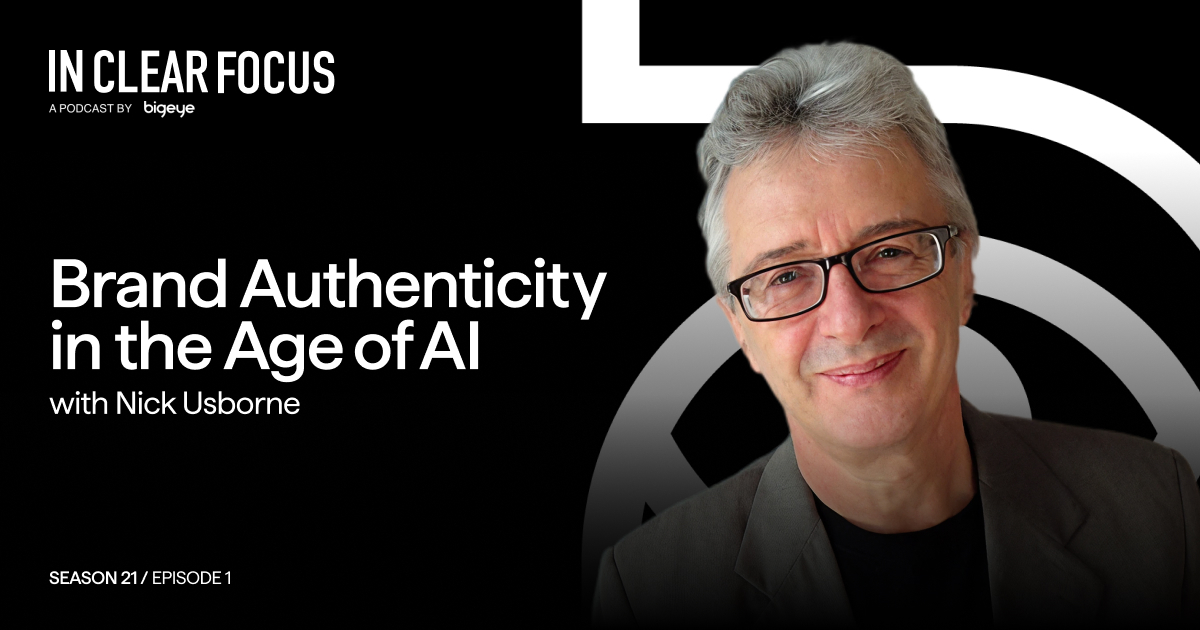IN CLEAR FOCUS: Guest Amanda Patterson, founder of Rocket Fuel Labs, discusses the rise of fractional CMOs and shares practical tips on developing effective marketing for startups and scaleups. Drawing from her experience scaling MINDBODY from $30M to $200M, Amanda details a data-driven “bottoms-up” plan for efficient growth. She explains why “brand builds demand,” the underrated power of customer journey mapping, and how to de-risk marketing spend for quick wins in a high-stakes environment.
Episode Transcript
Adrian Tennant: Coming up in this episode of IN CLEAR FOCUS
Amanda Patterson: With email marketing, digital advertising, there are so many ways to test. I think that it’s kind of a golden age of marketing for that reason. It’s really great the way you can just see what the market says, do kind of real-time research.
Adrian Tennant: You’re listening to IN CLEAR FOCUS, fresh perspectives on marketing and advertising produced weekly by Bigeye, a strategy-led, full-service creative agency growing brands for clients globally. Hello, I’m your host, Adrian Tennant, Bigeye’s Chief Strategy Officer. Thank you for joining us. startups and scaleups face marketing challenges that differ significantly from those of established brands. While Fortune 500 companies have dedicated teams and substantial budgets, emerging businesses must be nimble, resourceful, and more data-driven, often without a full-time Chief Marketing Officer. This gap has created demand for fractional CMO services, experienced marketing executives who provide strategic guidance for businesses that need C-level expertise but aren’t ready for a full-time hire. Our guest today is a pioneer in this space. Amanda Patterson is the founder and CEO of Rocket Fuel Labs, a growth marketing agency specializing in helping startups accelerate growth through data-driven strategies. Amanda scaled MINDBODY, a leading SaaS platform for wellness, fitness, and beauty businesses, from $30 million to over $200 million in revenue, oversaw their IPO, and delivered a 300% increase in leads. She then partnered with Priceline founder Michael Loeb to create Rocket Fuel Labs, which was named one of Inc. Magazine’s Best Places to Work in 2024. To discuss how the marketing needs of startups differ from established brands and how fractional marketing leadership is transforming the industry, I’m delighted that Amanda is joining us today from Austin, Texas. Amanda, welcome to IN CLEAR FOCUS.
Amanda Patterson: Thank you. Thanks so much for having me.
Adrian Tennant: Amanda, let’s start with your background. As I mentioned in the introduction, you helped scale MINDBODY from $30 million to over $200 million in revenue. How did that experience shape your marketing approach?
Amanda Patterson: I think one of the things that taught me, especially because MINDBODY IPO’d while I was there, is to run marketing programs as if you’re already a public company before you actually get there. So the discipline of being able to accurately forecast and put together a plan, I refer to it as a “bottoms-up” plan, but a very detailed plan to achieve those revenue targets is really important. So it taught me to be data-driven, to set goals, to set projections. And then the other thing I learned at MINDBODY is that brand builds demand, so the brand is really, really important to actually hitting those goals. And there is no silver bullet campaign or solution. When you’re trying to grow that quickly and be one of a very, very few companies to IPO, you really need to be firing on all cylinders. You need to be testing all the time, not satisfied with whatever you’re currently achieving ever, and really trying to figure out what are the little ways that we can move the needle because 10 little changes or tweaks or adjustments to campaigns can add up quickly to very big numbers. So those are some of the things that come to mind. I know that’s several things, but many of the things I learned in that journey.
Adrian Tennant: Amen to brand builds demand!
Amanda Patterson: Yes.
Adrian Tennant: So Amanda, what inspired you to leave the executive world and start Rocket Fuel Labs?
Amanda Patterson: I was very much inspired by the entrepreneurs that were MINDBODY clients. And so just kind of working with small business owners and seeing their success and their achievement and their journey made me want to do that myself. And then I also was very inspired by Michael Loeb, who was the person who approached me for this opportunity and just the chance to work with him was something I could not pass up.
Adrian Tennant: How did that partnership come about?
Amanda Patterson: So initially I was reached out to actually by a recruiter because Michael came up with the idea for Rocket Fuel Labs. He has a portfolio of startups and he is very passionate about entrepreneurs as well and helping them and really saw a gap in the market where these early-stage companies were not getting the strategic support that they need to succeed. So yeah, so a recruiter connected us initially. We had a conversation, started talking and just felt like it was the right time to do something like that and took that opportunity.
Adrian Tennant: Can you explain the concept of fractional CMO services and the reasons behind the high demand for this model?
Amanda Patterson: Well, you know, most companies don’t start looking for a full-time CMO until they’re really post-series B or series C in their journey. And they feel like they need somebody who’s done it before. We need somebody who knows how to IPO. But what I have found is that they really need that strategy way earlier, and having that strategic support earlier in their journey would actually help them grow faster than they otherwise would. I think a lot of companies are starting to realize that. And instead of just trying to run marketing themselves, manage a bunch of different agencies and freelancers, and consultants, they’re realizing, “Gosh, I really need a fractional CMO to help me make some of these decisions. Someone who’s been around the block, who’s made mistakes that I’m hoping to avoid making and has achieved success that I’m hoping to achieve.” So I think companies are just starting to see the value of that.
Adrian Tennant: What specific services does Rocket Fuel Labs offer to help startups scale their marketing efforts?
Amanda Patterson: Yeah, so we offer a marketing strategy for sure. So every client we work with gets that strategic support, that bottoms-up plan to help them hit their numbers. But we also have a marketing operations team that can implement tech tools, tracking tools, CRMs like HubSpot, Salesforce, SendGrid, Klaviyo, things like that. We do demand generation marketing and performance marketing as well. And that includes everything from websites to digital advertising, search marketing, SEO, email marketing, account-based marketing, and we do brand and positioning work for our clients also.
Adrian Tennant: Excellent. How do the marketing needs of startups and scaleups differ from those of more established businesses, would you say?
Amanda Patterson: I would say the stakes are very high. They really don’t have the budget to “spray and pray,” as I call it, or to spend a lot of money on awareness marketing. They’re very risk-averse. They want to kind of de-risk their marketing investment, which is why they come to us. And they need quick wins. When you’re a startup, you have to build the rocket ship while you’re flying it at the same time, which is really tricky and difficult. That’s why I think getting that expertise sooner rather than later is going to actually help them do that, help them build the rocket ship while they’re flying it, which is, by the way, why we’re called Rocket Fuel Labs. That’s the inspiration behind the name. And I would say also, especially today, it’s very different for startups than it was, say, in the 2010s. They’re expected to grow efficiently. So, you know, 10, 15 years ago, there was this mentality of “Just grow at any cost and don’t worry about your cost of acquisition until later.” But now investors obviously in this market are singing a really different tune, and they expect startups to grow efficiently and to be able to show a path to profitability, if not profitability, much earlier. Partnering with an agency or a marketer that is good at spending money is pretty easy, but finding a partner that can help you save money and help you figure out how to grow in a scrappy way on a budget can be a lot more difficult.
Adrian Tennant: Amanda, let’s talk about balancing brand and demand generation. How do you help your clients create an integrated marketing strategy that serves both purposes?
Amanda Patterson: So when it comes to brand, we encourage our clients to listen to the customer. The voice of the customer should be coming out in your marketing. I always say you want your prospects to feel like you’ve read their diary or to feel like you know exactly what they’re thinking and reading their mind. And the only way to do that is to actually have them tell you what they’re thinking. So we really start there, and you don’t have to pay Forrester or some big research company to figure this out. Like sometimes just having conversations with 5 to 10 customers and listening to the words that they’re using to describe their product, asking them, “When you talk about our product, what do you say?” And then letting that inform your brand promise. Now, for us, that is foundational. So if our clients don’t know what their unique brand promises or what makes them compelling and differentiating to the market, we will actually start there and say, “OK, we need to figure out what is your compelling and differentiating and true brand value proposition. Because otherwise we can get in front of the right people, but if we’re not saying the right thing, they’re not gonna respond, and you’re just gonna waste your money.” So it’s not so much about balancing it as it is like, “This is a key ingredient to the success of your campaign. So let’s make sure we know what your value proposition is.” Really, really important.
Adrian Tennant: Well, relatedly, when we were preparing for this podcast, you mentioned to me that customer journey mapping is, in your view, one of the most underrated marketing strategies. Amanda, why do you think it is so important?
Amanda Patterson: I think because it’s an opportunity to figure out where and when in their kind of journey, they are the most ready to buy and get in front of them at that moment. Get in front of them at the moment when they’re most likely to fill out a form, request a demo, sign up for a trial, do whatever it is you want them to do. So what a lot of companies do is they create, for example, they’ll say, “We need to write a blog” or “We need to create a white paper,” “We need to create a webinar to generate leads.” And they’re not thinking about who is going to be looking at that content, and what phase of the funnel they’re in. For example, at the top of the funnel, you have people who maybe have never heard of you before. So are you creating a white paper to get them to hear about you? Or are you inviting them to a webinar that’s showing them a demo of the product? If it’s a demo, then they’re at a different phase in the journey. You want to make sure that you’re marketing that webinar to people who are actually experiencing the problem that you’re trying to solve, and they’re looking for a solution. So understanding where they are in the journey ensures that you’re offering them the right thing at the right time. It’s like to use a restaurant analogy, you’re not gonna put a breakfast menu in front of people at 5 p.m. in the evening when they’re ready for a burger. So it’s just that same logic of make sure you’re offering them something a part in their journey when they’re most likely to respond.
Adrian Tennant: We love case studies on IN CLEAR FOCUS. So Amanda, do you have an example of a client you’ve worked with that exemplifies how your approach works?
Amanda Patterson: Yeah, one client that I think is a really good example is a company called Gloss Genius, and it is booking and business management software for salons. And the reason it’s such a great case study is because we started working with them when they were a seed-stage company. So they were pre-series A, and they did not have any full-time marketing hires. They were working with some contractors and things like that. And I was able to sit down with them and really help them build a bottoms-up plan for marketing using our formatting and templates, and helping them figure out how to accurately project how many trials – they had a free trial at the time – trials and paid customers they were going to get from every single campaign. We helped them also set up and manage, and run all of their marketing campaigns, including email, digital, even some account-based marketing, which we introduced. So they were not doing that previously, and we ran some of those campaigns. We helped them refine their positioning and test different headlines and offers, and calls-to-action on all of the campaigns that we ran. We helped them hit their numbers really consistently and successfully, increasing their signups by almost doubling it. I think it was like 85% in the first year that we worked together. And then it just continued to grow from there. And we also helped them reduce their cost of acquisition, which was another really important KPI. And during the time that we were their agency, they actually raised three major rounds, so Series A, B, and C, while we were their agency of record. And the last round, I believe they were at a $500 million valuation. So just to see a client grow from seed stage to Series C and be part of that journey along the way was just really fun, really rewarding, and I’m so happy for all of their amazing success.
Adrian Tennant: Let’s take a short break. We’ll be right back after this message.
 |
Sorin Patilinet: Hello, I’m Sorin Patilinet, the author of Marketing Effectiveness: Applying Marketing Science for Brand Growth published by Kogan Page.
Drawing on my over 20 years of experience, I reveal how marketers can bridge the gap between creativity and analytics to drive sustainable growth. Whether you’re a mid- to senior-level marketeer facing pressure to deliver quantifiable results, or someone looking to integrate advanced measurement into your marketing strategies, my book provides practical frameworks and real-world examples from brands like Snickers, Unilever’s Dove, and M&M’s. You’ll discover how to leverage neuroscience or machine learning to deepen customer understanding, navigate AI’s evolving role in marketing, and lastly, develop the skills needed to thrive as a modern marketeer. As an IN CLEAR FOCUS listener, you can save 25% on Marketing Effectiveness when you order directly from KoganPage.com. Just enter the exclusive promo code BIGEYE25 at checkout. Shipping is always complimentary for customers in the US and the UK. I hope my book helps you apply marketing science to create measurable success and elevate your marketing career. Thank you! |
Adrian Tennant: Welcome back. I’m talking with Amanda Patterson, founder and CEO of Rocket Fuel Labs, about how the marketing needs of startups and scaleups differ from established businesses. Amanda, Rocket Fuel Labs was named one of Inc. magazine’s best places to work in 2024. What does workplace culture mean to you as a leader?
Amanda Patterson: Workplace culture to me means that everyone on my team is enjoying their life. They’re enjoying their job. They feel like what they’re doing is purpose-driven and rewarding. They feel like they’re learning and growing professionally. They have a good relationship with their coworkers, with their managers. And, you know, we’re celebrating the wins, which I also think is super important in a company culture. So yeah, that’s the kind of culture we definitely try to foster at Rocketfuel.
Adrian Tennant: What advice would you give to startup founders who are trying to figure out their marketing strategy on a really limited budget?
Amanda Patterson: My advice would be, of course, I would say get some expert support because hiring a fractional CMO de-risks the investment. If you work with someone who has tested and tried as much as, for example, we have – we’ve worked with dozens of companies at this point – and has seen a lot of success, that’s just going to give you a lot of insight because that person or firm is going to help you know what’s worked with other companies that are similar to yours, have a similar motion or go to market or similar strategic issues. The other piece of advice I would say is to make sure that your audience targeting is really, really tight and focused, and think about ways to segment beyond just the surface level stuff. And especially if you’re B2C, if you’re like, “Yeah, I’m targeting Gen Z,” or “I’m targeting Boomers,” or “All women over 45,” – these are huge, huge, huge demographics and you will spend a lot of money getting your ads in front of the wrong people who are just not interested in what you’re selling. So I think it’s really important to figure out who your audience is and narrow it down. And when you think you’ve got it narrowed down, like try to narrow it down even further. Because that to me, that’s where I see the most waste in terms of marketing spend – is just people spending their money in front of the wrong people.
Adrian Tennant: What role does data play in your marketing strategies? And I’m curious how you balance analytics with creativity.
Amanda Patterson: That’s a great question. In marketing, I think instinct is actually always going to be very important because, at the end of the day, marketing is the art of communication, and there’s also some human psychology, understanding another person’s point of view and being able to communicate in a way that moves them emotionally or moves them to action. However, data is a huge, huge tool that is integral, absolutely necessary, and will just help you make better communication decisions. So the instinct, it doesn’t remove the need for gut instinct, the instinct really comes in when you’re putting the creative together and trying to, you know, figure out what’s the best way to communicate what we’re trying to say. But the data is going to tell you whether your instinct was right. So there’s really no reason these days to launch a campaign without launching a test plan, and testing different headlines. And this is the one, like I always go into a campaign with a strong opinion and instinctively, this is the one I think is going to work. But sometimes I’m wrong. And you can find out very quickly, especially with email marketing, digital advertising. There are so many ways to test and I think that it’s kind of a golden age of marketing for that reason. It’s really great the way you can just see what the market says, do real time research.
Adrian Tennant: Well, as we’ve discussed in previous episodes of IN CLEAR FOCUS, AI is transforming marketing. Amanda, what’s your perspective on how artificial intelligence is impacting the industry?
Amanda Patterson: I think that AI is just a phenomenal tool that allows you to create faster. So it certainly can speed up the process of creating ads, creating different reports, of course, like the ability to see the data in real time. There’s just a lot more opportunity, I think, in that way. It is a great way to personalize your campaigns and leverage data to make them a little bit more on-point, if you will, to your different audiences. I do think that AI is going to impact search marketing, and it already is in a very big way, in a way that almost nobody is prepared for. So that is something that we’re keeping a really close eye on and trying to help our clients navigate as well. So yeah, so it helps with execution, it speeds up efficiency, there’s a lot of great tools. You can’t outsource all creative to AI. I think the average consumer can tell if something was written by ChatGPT, they can tell if a commercial or a video is 100% AI-generated people. And there’s a time and a place where I think it’s okay to use AI people and AI photos. And we certainly have. But that’s really where the instinct comes in, in knowing when is it a good time to use it, when should you use real people, and how do you strike that balance. So it’ll be interesting to see. I think the most successful marketers are going to be the ones that have the best instinct about that.
Adrian Tennant: That’s interesting. Are there any particular AI tools, either general tools or very specific agency-type tools that you are finding you’re excited about using?
Amanda Patterson: We use Suidoo for, it’s called Suidoo for reporting. We use … Adobe has some great AI tools, plugins that we’re using, as does HubSpot. Of course we use ChatGPT a lot, especially when we’re using it for ideation or research and things like that. And then of course, we are also using a tool called Gong, which from an agency perspective, you know, most people think of Gong as a sales tool, but it’s actually a great tool for agencies because it allows you to record client meetings and create reports and to-dos and help ensure that not every single person in the agency has to be in every single meeting. So those are just a few of the tools. There are others that we’re using, but I would say those are some of the big ones.
Adrian Tennant: Thanks for sharing. And looking ahead, how do you see the fractional executive model evolving in the marketing industry?
Amanda Patterson: I think that the fractional model is going to grow in popularity just because it is so incredibly useful, especially for early-stage companies and helping them de-risk their marketing spend. And I would also say marketing is getting a lot more difficult to navigate in the age of AI. People don’t know what to do, and they have even less kind of confidence in their ability to figure it out on their own. I get asked all the time, you know, “How do we optimize for search with AI? How do I get my company ranked in ChatGPT?” or just things like that. People just don’t know. “What AI tools should I use in my business and what should I look for?” So I think it’s going to be just a very popular service in the foreseeable future, for sure.
Adrian Tennant: Great conversation. Amanda, if listeners would like to learn more about Rocket Fuel Labs and your services, what’s the best way for them to do so?
Amanda Patterson: Yeah, so the best way to reach us is to go to our website at rocketfuellabs.com. You can also email me directly at amanda@rocketfuellabs.com.
Adrian Tennant: Perfect. Amanda, thank you very much for being our guest this week on IN CLEAR FOCUS.
Amanda Patterson: Thank you. Thanks for having me.
Adrian Tennant: Thanks again to my guest this week, Amanda Patterson, founder and CEO of Rocket Fuel Labs. As always, you’ll find a complete transcript of our conversation with timestamps and links to the resources we discussed on the IN CLEAR FOCUS page at Bigeyeagency.com, just select ‘Insights’ from the menu. Thank you for listening to IN CLEAR FOCUS, produced by Bigeye. I’ve been your host, Adrian Tennant. Until next week, goodbye.
TIMESTAMPS
0:00: Introduction to IN CLEAR FOCUS
0:30: Marketing Challenges for Startups vs. Established Brands
1:25: Meet Amanda Patterson
2:18: Lessons from Scaling MINDBODY
4:09: Inspiration Behind Rocketfuel Labs
4:50: The Concept of Fractional CMO Services
5:35: Services Offered by Rocket Fuel Labs
6:45: Differences in Marketing Needs: Startups vs. Established Businesses
7:36: Balancing Brand and Demand Generation
9:00: The Importance of Customer Journey Mapping
11:00: Case Study: Gloss Genius
15:13: Workplace Culture at Rocket Fuel Labs
16:57: Advice for Startup Founders on a Budget
17:45: The Role of Data in Marketing Strategies
19:25: Impact of AI on Marketing
21:08: AI Tools in Use at Rocket Fuel Labs
23:02: The Future of the Fractional Executive Model
24:15: Closing Remarks and Contact Information



